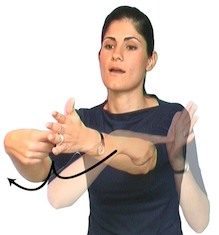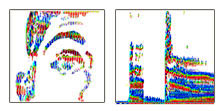![]()
While all extant spoken languages are thousands of years old or descended from old languages, only sign languages can be born at any time, allowing researchers a glimpse of human language in its most essential form. Al-Sayyid Bedouin Sign Language (ABSL) arose spontaneously a mere 80 years ago in a stable existing community in southern Israel with a high incidence of genetically transmitted deafness – well over 130 of the 4,000 villagers are deaf. The language continues to be used by deaf and hearing people, offering the research team an opportunity to chart its development over time. Investigations by researchers Wendy Sandler and Irit Meir (University of Haifa), Carol Padden (University of California San Diego/CRL), and Mark Aronoff (SUNY-Stony Brook) reveal how a language begins, and how it slowly but surely accrues linguistic structure.
The team has created a Dictionary of Al-Sayyid Bedouin Sign Language with 300 entries, and including a brief history of the village and its earliest signs, as told by Saleh Al-Sayyid. Click to read the Introduction to the dictionary in Arabic, Hebrew and English.
Story of the history of the Al-Sayyid Bedouins, told by one of the first deaf signers of their language
Press:
Science. 2016. How sign languages evolve
New York Magazine Science of Us 2016
Nautilus. 2014. The unusual language that linguists thought couldn’t exist.
The New York Times, Ha’aretz , Discover Magazine
Talking Hands, a book for a general readership by New York Times writer Margalit Fox www.talkinghandsbook.com.
Press (Hebrew):
Publications:
- Meir, Irit, Aronoff, Mark, Börstell, Carl, Hwang, So-One, Ilkbasaran, Deniz, Kastner, Itamar, Lepic, Ryan, Lifshitz Ben-Basat, Adi, Padden, Carol, and Sandler, Wendy. (2017). The Effect of Being Human and the Basis of Grammatical Word Order: Insights from Novel Communication Systems and Young Sign Languages. Cognition 158. 189-207.
- Lepic, Ryan, Börstell, Carl, Belsitzman, Gal, & Sandler, Wendy. (2016). Taking Meaning in Hand: Iconic Motivations in Two-handed Signs. Sign Language and Linguistics.
- Sandler, Wendy. 2016. What Comes First in Language Emergence? In N. Enfield (Ed.) Dependency in Language: On the Causal Ontology of Language Systems. Studies in Diversity in Linguistics 99. Berlin: Language Science Press. 67-86.
- Sandler, Wendy, Aronoff, Mark, Padden, Carol & Meir, Irit. (2014). Language emergence. In J. Sindell, P. Kockelman & N. Enfield (Eds.), The Cambridge handbook of linguistic anthropology (pp. 250-284). Cambridge: Cambridge University Press.
- Sandler, Wendy. 2014. Emergence of phonetic and phonological features in sign language. Nordlyd 41/2, 183-212.
- Sandler, Wendy. (2013). ‘Vive la différence. Sign language and spoken language in language evolution’. Language and Cognition 5 (2-3), 189-203.
- Padden, Carol, Meir, Irit, Hwang, So-One, Lepic, Ryan, Seegers, Sharon, and Sampson, Tory (2013). Patterned iconicity in sign language lexicons. Gesture 13(3): 287-308.
- Kastner, Itamar, Irit Meir, Wendy Sandler, Svetlana Dachkovsky: ‘The Emergence of Embedded Structure: Insights from Kafr Qasem Sign Language.’ Froniters in Psychology, vol. 5, 1-15. doi: 10.3389/fpsyg.2014.00525
- Tkachman, Oksana & Sandler, Wendy. (2013). The noun-verb distinction in two young sign languages. Gesture (13:3), special issue, Where do Nouns Come From? J. Haviland (Ed.), 253-286.
- Meir, Irit, Assaf Israel, Wendy Sandler, Carol Padden, and Mark Aronoff (2013). ‘Community structure and language structure’. Linguistic Variation, 12(2), 247-291
- Meir, Irit, Wendy Sandler, Carol Padden, and Mark Aronoff (2013). ‘Competing Iconicities in the Structure of Languages’. Cognitive Linguistics, 24(2), 309-343.
- Sandler, Wendy. (2012). ‘Dedicated gestures and the emergence of sign language’. Gesture 12/3, 265-307.
- Sandler, Wendy (2011). ‘Prosody and syntax in sign language’. Transactions of the philological society, 108, 298-328.
- Sandler, Wendy, Aronoff, Mark, Meir, Irit, Padden, Carol. 2011. ‘The Gradual Emergence of Phonological Form in a New Language’. Natural Language and Linguistic Theory, 29, 503-543.
- Sandler, Wendy, Irit Meir, Svetlana Dachkovsky, Carol Padden, and Mark Aronoff (2011). ‘The emergence of complexity in prosody and syntax’, Lingua, 121, 2014-2033.
- Israel, Assaf, and Wendy Sandler (2011). ‘Phonological category resolution: A study of handshapes in younger and older sign languages’. In R. Channon and H. van der Hulst (Eds.), Formational Units in Sign Languages. Berlin/Boston/Nijmegen: De Gruyter / Ishara Press. 177-202.
- Meir, Irit, Aronoff, Mark, Sandler, Wendy & Padden, Carol (2010). ‘Sign languages and compounding’. In: S.Scalise, and I.Vogel (Eds.). Compounding. John Benjamins, 301-322.
- Padden, Carol, Irit Meir, Mark Aronoff, and Wendy Sandler. (2010). ‘The grammar of space in two new sign languages.‘ In: D. Brentari (Ed.). Sign Languages: A Cambridge Survey. New York: Cambridge University Press, 573-595.
- Meir, Irit (2010). ‘The Emergence of Argument Structure in Two New Sign Languages‘. In: M. Rappaport Hovav, E. Doron, and I. Sichel (Eds.). Syntax, Lexical Semantics and Event Structure. Oxford University Press, 101-123.
- Sandler, Wendy (2010). ‘The uniformity and diversity of language: Evidence from sign language’. Response to Evans and Levinson. Lingua, 120, 2727-2732.
- Meir, Irit, Wendy Sandler, Carol Padden, and Mark Aronoff (2010). ‘Emerging sign languages’.In: M. Marschark, and P. Spencer (Eds.) Oxford Handbook of Deaf Studies, Language, and Education, Vol. 2. Oxford: Oxford University Press, 267-280.
- Padden, Carol, Irit Meir, Wendy Sandler, and Mark Aronoff (2010). ‘Against all expectations: Encoding subjects and objects in a new language’. In: D. Gerdts, J. Moore, and M. Polinsky (Eds.). Hypothesis A/Hypothesis B: Linguistic Explorations in Honor of David M. Perlmutter. Cambridge, MA: MIT Press.
- Al-Fityani, Kinda, and Carol Padden (submitted paper). ‘Sign language geography in the Arab world’. In: D. Brentari (Ed.). Sign Languages: A Cambridge Language Survey. New York: Cambridge University Press.
- Aronoff Mark, Irit Meir, Carol Padden, and Wendy Sandler (2008). ‘The roots of linguistic organization in a new language’. In: D. Bickerton, and M. Arbib (Eds.) Holophrasis, Compositionality and Protolanguage, Special Issue of Interaction Studies, 133-149.
- Meir, Irit, Carol Padden, Mark Aronoff, and Wendy Sandler (2007). ‘Body as subject’. Journal of Linguistics, 43, 531-563.
- Sandler, Wendy, Irit Meir, Carol Padden, and Mark Aronoff (2005). ‘The Emergence of Grammar in a New Sign Language’. Proceedings of the National Academy of Sciences, Vol. 102, No. 7, 2661-2665.
- Aronoff, Mark, Carol Padden, Irit Meir, and Wendy Sandler (2004). ‘Morphological universals and the sign language type’. In: G. Booij, and J. van Marle (Eds.). Yearbook of Morphology 2004. Dordrecht / Boston: Kluwer Academic Publishers, 19-40.
MA theses:
- Israel, Assaf (2009). Sublexical variation in three sign languages. MA thesis. University of Haifa.
- Tkachman, Oksana (2013). The basic noun-verb distinction in two young sign languages. MA thesis. University of Haifa.



